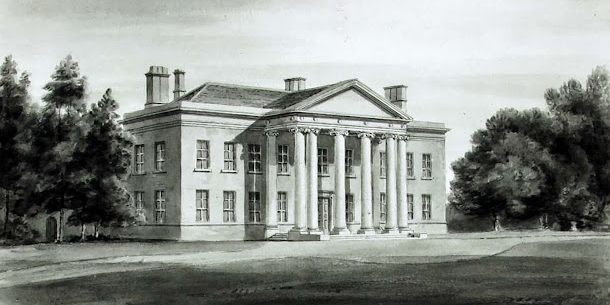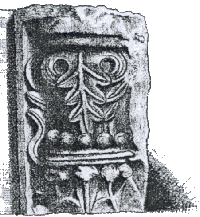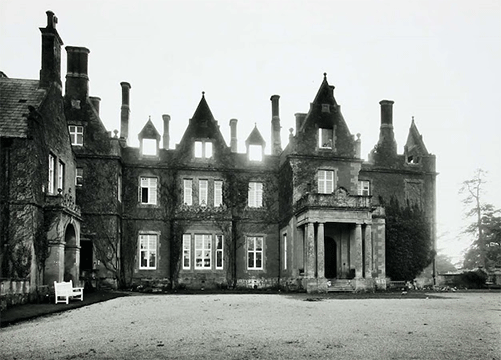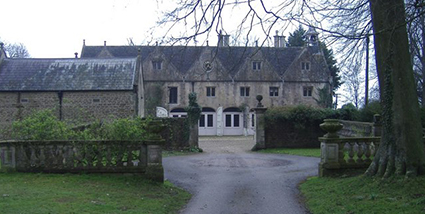
|
Half way up Bowden Hill between Bowood and Lacock Abbey, stood Spye Park House, the seat of the Bayntuns. "I
think Spye Park is one of the prettiest places in the world, or in
all events it has more natural beauty than most. In every description
the views are so varied and the grounds so picturesque. The park is
very large and one could wander about for many hours admiring and
exploring". |
Spye
Park, the seat of generations of the Bayntun family and was situated
about two miles to the north of Bromham village and close to the great
Roman road from London to Bath. To the south-east was the bold plateau called Roundaway Hill, with its commanding encampment on the summit, a range of lofty chalk-hills extended thence for several miles and to the east, on the southern face of which was the White Horse of Cherhill, and above it, another encampment called Oldbury Castle. At the extremity of the park, towards the west, the grounds sloped gradually to the River Avon and its fertile meadows to the old gatehouse called Spye Arch, where a very extensive tract of country unfolded. Whilst the plantations of Bowden Park and the venerable Abbey of Lacock attract the eye near the foreground, the lofty free-stone hills around Bath could be seen in the middle distance and a large tract of Gloucestershire was obscured, extending to the north-east whilst the more picturesque and romantic features of Somersetshire were beheld, stretching to the horizon, in the west and south-western directions. The sketch (above) shows the house as it was in 1684, with a partially sunken storey at ground level, a principal storey or first floor with nine large windows and steps leading up to the main entrance. The second floor had a range of nine smaller windows and there were two gables with windows in the attic. On the left hand side and four dormer windows equally spread across the roof space to the right. 30 years earlier, John Evelyn mentions in his famous Diaries that he visited the house on the 19th July 1654 before it was completed. He says of his visit: "We went to Sir Edward Bayntun's at Spye Park, north of Bromham village, a place capable of being made a noble seat. But the humorous old Knight has built a long single house of two low stories on the precipice of an incomparable prospect and landing on a bowling green in the park. The house is like a long barn and has not a window on the prospect side". This cannot be seen from the sketch (above) but there is no doubt the drawing has been carried out exactly as John Evelyn described it in regard to the front of the house. The two stories referred to were those above ground. It
was here the Bayntun family moved to, following the destruction of
Bromham House,
during the Civil War in 1645 and quite possibly first lived in the
small house, or hunting lodge (pictured at the bottom of the above
illustration) called Spye Park Lodge, while waiting for
the mansion to be completed. By 1654 Sir Edward Bayntun (1593 - 1657)
had finished building a large house which was decorated with carved
masonry taken from the ruins of the famous Bromham House, which at
the time, was used as a quarry. He had also added some very rich furniture.
The
new house was enclosed by a high wall and the arched gateway of the
17th century, almost directly opposite the main entrance. The steps
from the main doorway at the front of the house led down onto a superb
enclosed bowling green. Above the sketch Dingley has drawn the combined
Bayntun/Thynne coat of arms. Sir Edward Bayntun, whom Evelyn visited,
was at the time married to Stuarta, the daughter of Sir Thomas Thynne,
whose brother resided at Longleat. The
stables also appear to have chimneys and it is thought that these stables
could perhaps have been an original house. Another theory is that Sir
Edward Bayntun had them built at the same time as the main house as
offices. The
original house had windows on the side next to the park and there may
very well have been a practical reason why there were no windows on
the prospect side. In those days, people were far less fond of exposed
situations and therefore it was very likely the windows were put on
the side least exposed to the wind. The gateway that was erected at the entrance to Bromham House, as a gift from Catherine of Aragon, was all that escaped the fire in 1645 and Sir Edward had it carefully dismantled and rebuilt once again, on it’s third site, at the entrance to the Spye Park estate. It stands today as the only evidence of the Bayntun's two fine houses and fully bears out the tradition of the magnificent character of the former Bromham House. Originally the gateway was the entrance to Stanley Abbey and is now known to locals as Spye Arch. Spye
Park House was often let to others, not necessarily connected to the
family, when the head of the household chose to live elsewhere. They
also had houses at Bath, Bathampton and Notton and most likely a town
house in London as well. But this transformation into a Georgian manor was not just restricted to the outside of the building. When Anne Bayntun died in 1734, her son and heir, Sir Edward Bayntun Rolt gained possession and also added a fine upstairs drawing room with a marvelous view on the south or prospect side of the house. This will be remembered as 'the handsomest room in the house' and projected from the old part of the mansion. It was later discovered that part of the walls for this extension were built from fragments which were definitely brought from the ruins of Bromham House. Then some time around 1749 the whole front
of the house above the sunken storey was completely altered and a massive
portico added. This included a
magnificent triangular shaped concrete structure at roof level with
eight concrete pillars towering above the entrance (pictured above).
The alteration was carried out by Edward Bayntun Rolt, the son of the
above mentioned Anne Bayntun and heir to the Bayntun estate. The main
entrance to the house, or doorway retained the same, or nearly the same,
position as in the original structure.
During the time of Sir Edward Bayntun Rolt, the park's venerable forest-like trees were sacredly preserved from the axe, but after his death in 1800, his son Sir Andrew Bayntun Rolt was criticised for removing a large amount of trees surrounding the mansion. The house stood upon lofty ground near the southwest extremity of the park and commanded great views of one of the best wooded areas in the county. In 1812, Spye Park was rented to Colonel Thornton, of Lincoln's Inn, Middlesex, a gentleman much noted in the annals of sporting and racing. The lease was for 21 years, if Sir Andrew should live so long, and included the mansion, with a mill, a herd of deer and lands, at an annual rent of £750. The new tenant wanted to replace the Bayntun portraits in the house with those of his own. He had an immense number of sporting and other valuable paintings of his own, together with a collection of rare and exotic plants and the lands were stocked with three wagon loads of bald-faced and other red deer, roebucks, Asiatic deer and partly-coloured fallow deer. This lease however was terminated, as per the initial contract, once Sir Andrew Bayntun Rolt died in 1816, and subsequently Maria Barbara Bayntun Starky and her husband John Starky moved in. Some time after 1816, Dr. John Starky, husband of Maria Barbara, the daughter of Sir Andrew Bayntun Rolt, added some more rooms to the house and pulled down the small detached building, floored with marble, shown at the bottom of Thomas Dingley's sketch (pictured above), marked 'A Private Room in the Garden'. In 1833 Charlotte Wyndham, the wife of John Edward Andrew Bayntun Starky – Maria Barbara's son and Lord of the Manor of Bromham – described Spye Park in one of her letters as: "One of the prettiest places in the world, or in all events it has more natural beauty than most. The views are so varied and the grounds so picturesque. The park is very large and one could wander about for hours admiring and exploring". But in 1864 John
Bayntun Starky – heir to the Bayntuns and the last Lord
of the Manor of Bromham to live at Spye Park House
– had debts so bad, his creditors foreclosed on him and all his
estates were sold, including Spye Park House and the Abbey of Stanley.
His stud was sold
at Spye Park and his estates were sold the following year. Derry Hill
and Bromham portions were sold for £175,000 to Lord Landsdowne
and Mr Goldney and the Spye Park Estate was bought for £100,000
by Major John W.G. Spicer (1817-1883), an army officer whose investment
in a Brewery had made his fortune. The Prince
of Wales (later King Edward VII) had previously offered £300,000
for the estates but John Bayntun Starky had refused it and the Royal
Family bought Sandringham instead.
Talbot had another theory, that perhaps Spye Park was older than 17th
century and more probably of the time of Henry VIII. This of course
is contrary to Evelyn's assertion that it was built in 1654, but it
often happens that a person is described as the builder of a house,
who in reality only altered it. However one thing is certain –
Spye Park was built from materials salvaged from the ruins of Bromham
House and this would indicate that Evelyn's account would be more accurate. The new house was on a grand scale, with a huge hall, library, dining
room, billiard room and several drawing rooms of various colours (red,
white and green). It was completed in 1869. It was a large three-storey
gabled building of red brick and had pierced strapwork parapets, slated
roofs and a wide balustraded terrace to the principal front. The
park surrounding the house was well wooded and in 1939 comprised of
more than 500 acres.
All that remains of the house today is the entrance porch and the house platform from which there are excellent views of the south-west. To replace the house, the 17th century former stables and coach house were converted into a new main residence for the Spicer family. Since the late 19th century there hae been some minor additions to the pleasure grounds but few alterations have been made in the park. The main entrance front of the Victorian house after the fire and before its demolition in 1974.
After the
fire, the charming 17th century stable block, built by the Bayntuns,
was converted to a dwelling for the Spicer family rather than
horses. This revitalised this marvelous building and most certainly
saved it from decay and subsequent dereliction in later decades.
Another interesting find, at that stage, was that when the roof timbers were uncovered during the conversion, they were found to be from ships from the navy of Charles I and a delightful turret clock that was mentioned in Kilvert's Diary. |
|
|







